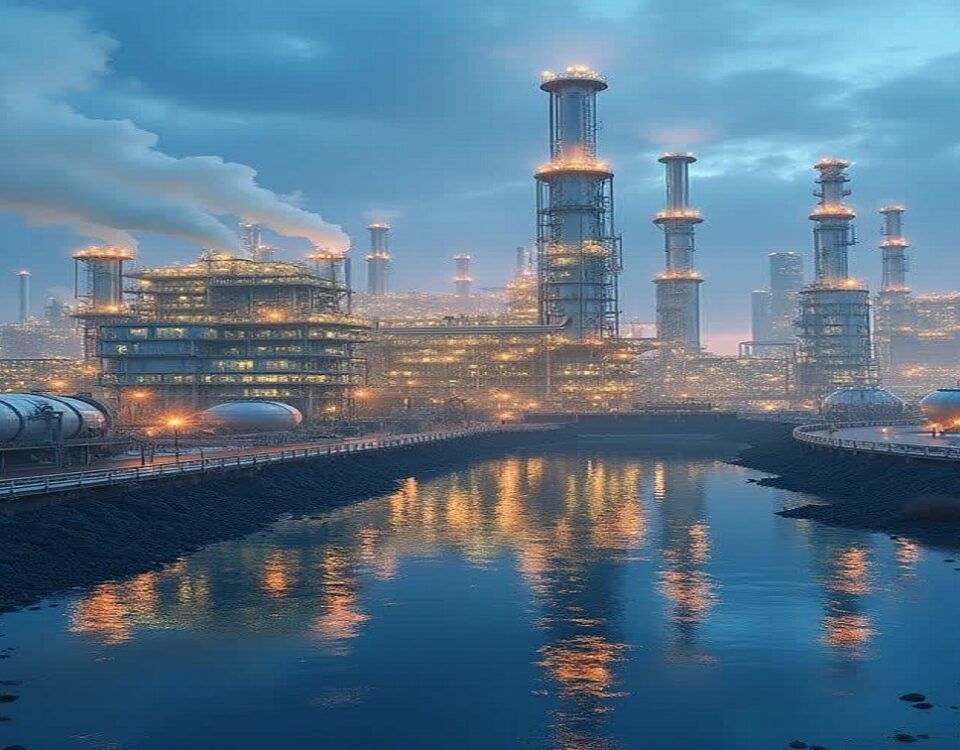
Software Training Courses
بهمن ۲۱, ۱۴۰۲
Training Courses
مهر ۴, ۱۴۰۳Introduction
The oil and gas industry, as one of the largest and most vital sectors of the global economy, has played a crucial role in meeting the world’s energy needs for decades. However, due to its central role in greenhouse gas emissions, particularly carbon dioxide, the industry is facing increasing pressure. Carbon reduction, or “decarbonization,” has become one of the top global priorities in the fight against climate change.
In response to this global challenge, the oil and gas sector is actively seeking to develop and adopt advanced technologies aimed at reducing carbon emissions and improving environmental sustainability. These technologies not only help mitigate the environmental impacts of oil and gas activities but also enable the industry to adapt to evolving international policies and social pressures.
Environmental Challenges
The processes associated with the extraction, production, refining, and transportation of oil and gas contribute significantly to the release of greenhouse gases, including carbon dioxide, methane, and nitrogen oxides. These gases increase atmospheric concentrations, exacerbating the greenhouse effect, which in turn leads to global warming and climate change. The consequences of climate change include rising temperatures, sea level rise, shifting precipitation patterns, and more frequent extreme weather events.

Additionally, oil and gas extraction and production often result in the degradation of natural habitats, water and soil pollution, and the loss of biodiversity. These environmental issues not only pose serious threats to ecosystems and wildlife but also carry widespread social and economic consequences. For instance, the depletion of freshwater resources or changes in rainfall patterns can lead to agricultural challenges, food shortages, and forced migration.
The Necessity of Carbon Reduction in the Oil and Gas Industry
Given the extensive environmental and economic impacts of greenhouse gas emissions, reducing carbon has become an unavoidable necessity for the oil and gas industry. In this regard, cutting-edge technologies have been developed to aid in carbon reduction efforts. These technologies include carbon capture and storage (CCS), energy efficiency optimization, the use of renewable energy sources, and the digitalization of production processes.
Furthermore, increasing social pressures and stringent environmental regulations imposed by governments and international organizations are pushing the industry toward carbon reduction and alignment with environmental standards. For example, the Paris Agreement, signed by many countries, sets specific targets for reducing carbon emissions in the coming years. Failure to comply with these regulations could result in economic repercussions, including sanctions and heavy fines.
The Importance of Carbon Reduction in the Oil and Gas Industry
Climate Change and International Commitments
Climate change, one of the greatest challenges of the 21st century, has captured global attention. In recent years, unprecedented global temperature rises and their consequences—such as sea level rise, increased extreme weather events, and altered precipitation patterns—have clearly demonstrated the harmful effects of greenhouse gas emissions. The oil and gas industry, as a major source of carbon dioxide emissions, plays a pivotal role in this process.
To combat this global crisis, the international community has taken serious actions. The Paris Agreement, signed in 2015, is one of the most important international accords aimed at reducing greenhouse gas emissions. Its main goal is to limit global temperature increases to below 2 degrees Celsius above pre-industrial levels, with efforts to restrict the increase to 1.5 degrees Celsius. To achieve this, countries have committed to reducing carbon emissions and advancing green technologies.

The oil and gas industry, due to its significant role in carbon dioxide emissions, faces growing pressure to adopt new technologies and structural changes to reduce emissions. Failure to comply with these commitments could lead to serious economic and social consequences for countries and companies operating in the sector.
Economic and Social Pressures
In addition to international commitments, economic and social pressures are driving the oil and gas industry toward carbon reduction. Increased public awareness of environmental impacts and climate change has led consumers and societies to demand changes in how energy is produced and consumed. These shifts in social attitudes directly influence investment decisions and the policies of oil and gas companies.
Moreover, government policies have changed drastically, with many countries now enacting stricter regulations to curb carbon emissions. These regulations may include carbon taxes, emission limits, and environmental penalties. If companies fail to comply, they could face heavy fines and operational restrictions.
Financial pressures from investors and financial institutions also play a crucial role in this trend. Investors are increasingly seeking more sustainable, low-carbon investment opportunities. Companies that do not move toward carbon reduction may find it difficult to attract investment, facing significant financial challenges.
Economic Benefits of Carbon Reduction
Although carbon reduction might initially appear as an additional cost for the oil and gas industry, in the long term, it can offer significant economic advantages. For instance, investing in carbon reduction technologies can lower energy costs, increase operational efficiency, and improve the company’s reputation.
Furthermore, companies that lead in adopting green technologies can gain a competitive edge in global markets. These companies not only enjoy increased support from governments and society but also become more attractive to investors due to reduced environmental risks.
Carbon Reduction Technologies
In response to environmental challenges and the need to reduce greenhouse gas emissions, the oil and gas industry is increasingly moving toward the development and implementation of carbon reduction technologies. These technologies play a critical role in mitigating the industry’s negative impacts on climate change and help meet both international and national climate commitments. This section provides an overview of the key types of carbon reduction technologies used in the oil and gas sector.
Carbon Capture and Storage (CCS) Technologies
Carbon Capture and Storage (CCS) is one of the most advanced and effective solutions for reducing carbon dioxide emissions in the oil and gas industry. This technology involves processes in which carbon dioxide generated during industrial activities is captured before it is released into the atmosphere, transported, and safely stored in underground reservoirs. The use of CCS can significantly reduce greenhouse gas emissions and help the oil and gas industry meet its environmental obligations.
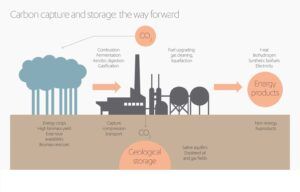
How CCS Works
The CCS (Carbon Capture and Storage) technology is divided into three main stages:
- Capture: In this stage, carbon dioxide (CO₂) is separated from gas streams generated during industrial processes such as refineries, power plants, and petrochemical units. This is done using various techniques like chemical absorption, physical absorption, membrane separation, and other methods. The choice of the appropriate method for capturing CO₂ depends on factors such as the concentration of CO₂ in the gas stream, costs, and operational conditions.
- Transport: After capturing, the CO₂ must be transported to a suitable storage location. This process is typically carried out through pipelines, though in some cases it can be transported by ships or specialized tankers. Safety and efficiency during CO₂ transportation are of utmost importance, as leaks or other issues could lead to gas release, increasing environmental impacts.
- Storage: Finally, CO₂ is injected into deep underground reservoirs, such as depleted oil and gas fields or suitable geological formations. These reservoirs are carefully selected to ensure that CO₂ remains securely stored underground for a long time without returning to the atmosphere. One of the benefits of using depleted oil and gas fields is their ability to store CO₂ under high pressure in safe conditions.
Benefits and Challenges of CCS
CCS technology offers significant benefits for the oil and gas industry. These include a substantial reduction in CO₂ emissions, increased environmental sustainability, and the ability to use oil and gas reserves for production without a significant increase in greenhouse gas emissions.
However, widespread use of CCS also faces challenges. High costs for installing and maintaining capture, transport, and storage equipment are major obstacles to its broad adoption. Additionally, the need for appropriate infrastructure to transport and store CO₂, along with geographical limitations that may prevent the use of underground reservoirs in certain areas, are other challenges facing this technology.
Future Potential of CCS
Given the need to reduce carbon emissions and global commitments to combating climate change, CCS technology is seen as a key tool for achieving carbon reduction goals in the oil and gas industry. Technological advancements and cost reductions over time may help increase the use of this technology. Moreover, government support and appropriate policy frameworks can play an important role in accelerating the development and deployment of CCS.
Optimizing Energy Use in the Oil and Gas Industry
Optimizing energy use is another effective strategy for reducing carbon emissions in the oil and gas industry. Given that extraction, production, refining, and transportation processes in this industry are energy-intensive, improving energy efficiency can significantly reduce the consumption of fossil fuels and, consequently, greenhouse gas emissions. This approach not only helps reduce environmental impacts but can also lower operational costs and increase the competitiveness of companies.
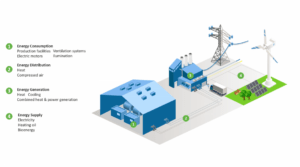
Methods for Optimizing Energy Use
Energy optimization in the oil and gas industry can be achieved through several methods:
Optimizing Production Processes
- Improving Equipment and System Performance: Upgrading and modernizing old equipment and using new technologies can increase efficiency and reduce energy consumption. For example, using advanced process control technologies, high-efficiency equipment, and heat recovery systems can help reduce energy waste.
- Enhancing Refining Operations: Refineries and petrochemical units are among the largest energy consumers in the oil and gas industry. Optimizing refining operations, such as using high-efficiency refining processes and reducing sudden downtime, can help reduce energy consumption in this sector.
Smart Energy Management
- Energy Management Systems (EMS): These systems allow companies to accurately monitor and control energy consumption. By collecting and analyzing energy consumption data, EMS can identify optimization opportunities and reduce energy waste.
- Using Smart Grids and the Internet of Things (IoT): These technologies can gather real-time energy consumption data and optimize production and energy distribution processes, helping reduce energy waste and improve overall energy efficiency in the oil and gas industry.
Energy Recovery and Waste Reduction
- Energy Recovery: Recovering wasted energy in production processes is an effective way to optimize energy consumption. For example, using heat recovery systems in refineries can convert wasted thermal energy into useful energy. This not only reduces energy consumption but also lowers operational costs.
- Gas Recycling and Emission Reduction: Recycling gases that are typically wasted, such as capturing and reusing gas emissions from extraction and production units, can serve as an energy source and reduce the need for fossil fuels.
Benefits of Energy Optimization
Optimizing energy use in the oil and gas industry not only helps reduce carbon emissions but also offers significant economic and operational benefits. These include reduced energy costs, improved operational efficiency, enhanced production quality, and reduced environmental risks. Additionally, companies that focus on energy optimization can directly benefit from environmental regulations and may qualify for tax incentives and government subsidies.
Challenges and Opportunities
While energy optimization presents many opportunities for the oil and gas industry, it also comes with challenges. High initial costs for installing and operating advanced equipment, as well as the need for technical expertise to manage and operate complex systems, are among these challenges. However, technological advancements and increasing awareness of the economic and environmental benefits of energy optimization can help overcome these challenges.
Using Renewable Energy in the Oil and Gas Industry
In an effort to reduce greenhouse gas emissions, the oil and gas industry is increasingly turning to renewable energy sources as a sustainable and low-carbon solution. These energy sources not only help reduce dependency on fossil fuels but also mitigate negative environmental impacts. Below is a review of different types of renewable energy and their role in the oil and gas industry.
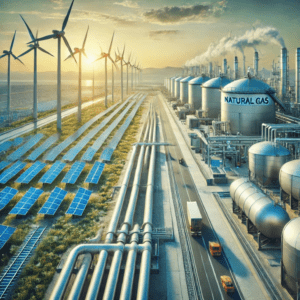
Solar Energy
Solar energy is one of the most widely used and accessible renewable energy sources. It can be used in the oil and gas industry in various ways:
- Powering Industrial Facilities: Solar panels can supply part of the energy needs of oil and gas production sites, reducing fossil fuel consumption and lowering carbon emissions.
- Heating and Cooling: Solar energy can be used for water heating, steam generation, and even cooling in industrial facilities, helping to reduce energy consumption and operational costs.
Wind Energy
Wind energy is another renewable source with high potential for supplying energy in remote and offshore areas where oil and gas activities are concentrated:
- Wind Turbines: Installing wind turbines near oil and gas production sites can help meet the electricity needs of these facilities, especially in coastal regions with abundant wind resources.
- Offshore Wind Farms: These farms can provide the energy needed for offshore oil and gas extraction and processing. Wind energy generated in these farms can be directly transferred to offshore facilities.
Geothermal Energy
Geothermal energy, another renewable source, can also be used in the oil and gas industry. This energy is derived from the natural heat beneath the Earth’s surface and can be used in the following ways:
- Electricity Generation: Geothermal energy can be used to generate electricity in regions with abundant geothermal resources, helping to supply energy to oil and gas production sites.
- Direct Heating: Geothermal energy can be used for heating industrial facilities and as a heat source in production processes, reducing dependency on fossil fuels and lowering greenhouse gas emissions.
Use of Renewable Energies in Combined Processes
In addition to the direct use of renewable energies, the oil and gas industry can benefit from combining these resources with other technologies:
- Combination with Carbon Capture and Storage (CCS) Technologies: Using renewable energies to supply the energy required for CCS processes can help further reduce carbon emissions.
- Support for Green Hydrogen Production: Utilizing renewable energies to produce hydrogen from water can serve as a clean fuel and an alternative to fossil fuels. This approach aids in reducing carbon emissions and increasing environmental sustainability.
Challenges and Opportunities of Using Renewable Energies
The use of renewable energies in the oil and gas industry comes with challenges such as installation and maintenance costs, geographical limitations, and the need for suitable infrastructure. However, technological advancements and increasing awareness of the environmental and economic benefits of renewable energy use can help overcome these barriers.
The Role of Hydrogen in Carbon Reduction in the Oil and Gas Industry
Hydrogen, as one of the clean and reliable energy sources, holds a special place in the future of the oil and gas industry. This lightweight and energy-rich fuel can significantly reduce greenhouse gas emissions in the sector. Specifically, green hydrogen, produced using renewable energy, has tremendous potential to replace fossil fuels and could be a key driver in global efforts to reduce carbon emissions. In this section, we explore hydrogen’s role in carbon reduction and its various applications in the oil and gas industry.
Hydrogen Production
Hydrogen is produced through various methods, each with different environmental impacts. In the oil and gas industry, particular attention is given to the production of green hydrogen and blue hydrogen:
- Green Hydrogen: This is produced through the electrolysis of water using renewable energy sources such as solar and wind. This process has zero carbon emissions, making it the cleanest form of hydrogen. As renewable energy production capacity increases, green hydrogen production is also expanding significantly.
- Blue Hydrogen: This type of hydrogen is produced through the reforming of natural gas combined with carbon capture and storage (CCS) technology. Although the production process involves carbon emissions, the use of CCS helps reduce these emissions, making it a viable option during the transition to cleaner energy.
Use of Hydrogen in Refineries
Hydrogen is widely used in refineries for hydrogenation processes and the desulfurization of crude oil. By replacing hydrogen produced from fossil sources with green or blue hydrogen, refineries can significantly reduce their carbon emissions. These changes not only help mitigate environmental impacts but also enable compliance with stricter environmental regulations.
Use of Hydrogen as Fuel in Transportation
Hydrogen can be used as a clean fuel for vehicles, ships, and airplanes. Particularly in maritime and aviation sectors, where reducing carbon emissions through electric technologies is limited, hydrogen presents an effective and high-potential alternative. The development of distribution and storage infrastructure for hydrogen is also crucial in this regard.
Use of Hydrogen in Power Generation
Hydrogen can be used as a clean fuel in power plants. The combination of hydrogen with oxygen in fuel cells produces electricity without carbon emissions. These power plants can act as a backup for intermittent renewable energy sources like solar and wind, contributing to the stability of power grids.
Challenges and Opportunities for Hydrogen Development
Although hydrogen has great potential for carbon reduction, its development and implementation face challenges:
- Production Costs: The production costs of green hydrogen are still higher compared to fossil fuels. However, with increasing production scale and technological advancements, these costs are expected to decrease.
- Transport and Storage Infrastructure: Developing appropriate infrastructure for hydrogen transport and storage is also a major challenge. Nonetheless, investments in this infrastructure can accelerate the adoption of hydrogen as a primary fuel.
- International Cooperation and Policy: To fully exploit hydrogen’s potential, international cooperation and supportive government policies are necessary. Such collaboration can improve infrastructure, reduce costs, and increase confidence in this technology.
Digitalization and Carbon Reduction
Digitalization, through the integration of digital technologies into industrial processes, plays a key role in reducing carbon emissions and improving energy efficiency. Technologies such as the Internet of Things (IoT), Artificial Intelligence (AI), and Big Data analytics help companies optimize their energy consumption and minimize carbon emissions.

- Energy Consumption Optimization: AI-based energy management systems can monitor and optimize energy consumption in real-time. These systems can analyze consumption patterns and determine the best time to use energy resources, preventing energy waste.
- Smart Process Control: Digitalization enables smart control of production processes, minimizing carbon emissions at every stage of production. For example, advanced automation technologies in refineries can control complex processes more precisely, preventing unnecessary greenhouse gas emissions.
Carbon Reduction Through the Digital Supply Chain
Digitalization not only plays a key role in production processes but also throughout the entire supply chain. Digital technologies can improve the efficiency of logistics, reduce fuel consumption, and lower carbon emissions in the supply chain.
- Smart Logistics Management: The use of smart logistics systems that optimize routes and transportation schedules based on real-time data can reduce fuel consumption and carbon emissions. These systems can dynamically determine the best routes based on traffic conditions and other factors.
- Transparency in the Supply Chain: Digitalization allows companies to manage their supply chains comprehensively and transparently. This transparency can help reduce carbon emissions by identifying and addressing inefficiencies in the supply chain.
Data Analysis and Carbon Modeling
Digitalization also enables more precise analysis of carbon emissions data. Using advanced modeling and digital simulations, companies can predict the impact of their actions on carbon reduction and make better decisions.
- Carbon Emissions Prediction and Simulation: The use of computer modeling to simulate various carbon emissions scenarios helps companies assess the likely outcomes of different actions and adopt more effective strategies for carbon reduction.
- Reporting and Compliance with Standards: Digital data analysis also helps companies produce more accurate reports on their carbon emissions and easily comply with international standards.
Impact of Digitalization on Environmental Policy Making
Digitalization can play an important role in shaping environmental policy. Digital data and analytical technologies help policymakers better understand the environmental impacts of their decisions and formulate more effective policies for carbon reduction.
- Monitoring and Controlling Carbon Emissions: Digital technologies such as sensors and monitoring networks can measure carbon emissions more accurately and in real-time, aiding the development of more precise and effective policies for carbon reduction.
- Development of Smart Policies: By analyzing big data, policymakers can identify long-term trends and patterns and develop smart, adaptive policies to address environmental changes.
Challenges and Opportunities of Carbon Reduction Technologies
Carbon reduction technologies are a key component of global efforts to combat climate change and reduce greenhouse gas emissions. However, the implementation of these technologies faces several challenges. At the same time, there are numerous opportunities to leverage these technologies and accelerate the carbon reduction process. In this section, we will explore the challenges and opportunities associated with carbon reduction technologies.
Challenges of Carbon Reduction Technologies
High Costs
One of the biggest challenges in implementing carbon reduction technologies is the high initial cost. For instance, installing and setting up wind turbines, solar panels, and carbon capture and storage (CCS) technologies require significant investment. Consequently, these costs can act as a major barrier for many companies and countries in adopting and implementing these technologies.
Emerging Technologies and Lack of Maturity
Many carbon reduction technologies are still in the early stages of development and have not yet fully matured. For example, new technologies like green hydrogen and biofuels may not have reached optimal levels of performance, efficiency, and cost-effectiveness. This lack of maturity therefore can delay the adoption and commercialization of these technologies.
Infrastructure Requirements
The implementation of carbon reduction technologies requires the development of new infrastructure. For example, expanding transmission and distribution networks to meet renewable energy demands, building facilities for carbon storage, and creating hydrogen transportation infrastructure all require investment and time. As a result, the absence of such infrastructure can slow the rapid adoption of carbon reduction technologies.
Social and Cultural Acceptance
The acceptance of new technologies requires changes in culture and societal attitudes. For instance, people and communities may resist new technologies like zero-carbon emission furnaces or hydrogen fuel cells. This resistance consequently can delay the adoption and implementation of these technologies.
Opportunities in Carbon Reduction Technologies
Reduced Operational Costs
Although the initial costs of carbon reduction technologies may be high, in the long run, they can lead to reduced operational costs. For example, solar panels and wind turbines reduce energy costs and result in long-term savings.
Job Creation
The development and implementation of carbon reduction technologies can create new job opportunities in various fields, including engineering, research and development, equipment production, installation, and energy management. Thus, these job opportunities can help boost economic growth and reduce unemployment.
Promotion of Innovation
The adoption and use of carbon reduction technologies can accelerate the process of innovation and the development of new technologies. Through investment in research and development of novel technologies, we can improve performance, reduce costs, and increase the efficiency of these technologies.
Improved Energy Security
Carbon reduction technologies can help reduce reliance on fossil fuel resources and improve energy security. For instance, renewable energy sources like solar and wind can provide sustainable energy and reduce the risks associated with energy price fluctuations and shortages.
Compliance with Regulations and Standards
The implementation of carbon reduction technologies can help companies and countries comply with environmental regulations and international standards. This, in turn, can help avoid penalties and sanctions, improve reputation, and create a competitive advantage.
Strategies to Overcome Challenges and Seize Opportunities
To overcome the challenges of carbon reduction technologies and capitalize on the opportunities, the following strategies can be helpful:
- Firstly, encouraging investment and financial support: Governments and international organizations can encourage investment in carbon reduction technologies through subsidies, financial facilities, and tax exemptions.
- Secondly, developing and enhancing infrastructure: Investment in developing the necessary infrastructure for implementing carbon reduction technologies, such as renewable energy networks and carbon storage facilities, can accelerate the adoption of these technologies.
- Additionally, increasing awareness and education: Conducting educational programs and raising public awareness about the benefits and applications of carbon reduction technologies can promote wider acceptance and use of these technologies.
- Finally, developing international cooperation: International cooperation in research and development, standardization, and experience sharing can help accelerate the development and adoption of carbon reduction technologies globally.
Prominent Projects in Carbon Reduction
Prominent projects in carbon reduction are examples of innovation in efforts to reduce greenhouse gas emissions and combat climate change. These projects often involve the use of novel technologies, sustainable strategies, and a multi-faceted approach to achieving carbon reduction goals. In this section, we will review several notable projects and their impact on carbon reduction.
Renewable Energy Projects
Noor Solar Park – Morocco

The Noor Solar Park in Morocco is one of the world’s largest and most advanced solar energy projects. This project specifically helps reduce dependence on fossil fuels and cut carbon emissions. The solar park has a capacity to generate over 500 MW of electricity and supplies energy to around one million homes. By replacing fossil fuels with solar energy, this project helps reduce about 760,000 tons of carbon dioxide annually.
Giddings Wind Project – United States

The Giddings Wind Project in Texas, United States, is an example of using wind energy for electricity generation. The project has a capacity to produce 300 MW of electricity from wind energy. Using wind energy instead of fossil fuels reduces annual carbon dioxide emissions by approximately 500,000 tons.
Carbon Capture and Storage (CCS) Projects
Boundary Dam – Canada
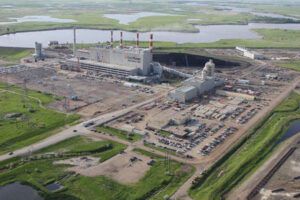
The Boundary Dam project in Canada is one of the pioneers in using carbon capture and storage (CCS) technologies. This project involves installing CCS systems on a coal-fired power plant, which is capable of capturing and storing over 1 million tons of CO2 annually. Using CCS technology significantly reduces carbon emissions by effectively storing the produced CO2 underground.
Sleipner – Norway
The Sleipner project in Norway is the first large-scale commercial CCS project that transfers CO2 produced from a gas field underground. This project stores CO2 in underwater reservoirs. So far, over 20 million tons of CO2 have been stored in this project, significantly helping to reduce carbon emissions.
Hydrogen Energy Projects
HyNet – United Kingdom
The HyNet project in the United Kingdom is one of the prominent projects in the development of hydrogen energy and carbon reduction. This project includes the production of green hydrogen from renewable sources and its use as clean fuel in various industries. HyNet has the potential to reduce around 1.8 million tons of CO2 annually by replacing hydrogen with fossil fuels.
H2Future – Austria
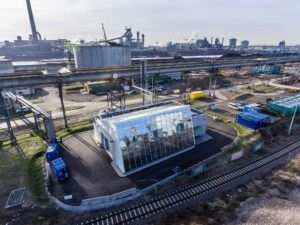
The H2Future project in Austria focuses on the production of green hydrogen through electrolysis of water using wind and solar energy. This project includes a large electrolysis unit capable of producing green hydrogen using renewable energy. The production of green hydrogen from renewable sources can significantly reduce CO2 emissions and improve energy efficiency.
Energy Optimization and Consumption Reduction Projects
Smart Grid – United States
The Smart Grid project in the United States is designed to optimize electricity distribution networks and increase energy efficiency. This project involves the use of smart technologies to manage the electricity grid and optimize energy consumption. Optimizing power grids and reducing energy waste can help reduce carbon emissions and save energy resources.
Green Buildings – Germany
The Green Buildings project in Germany includes the design and construction of energy-efficient buildings that use renewable energy sources. This project involves the use of advanced insulation, efficient heating and cooling systems, and solar panels. Green buildings help reduce carbon emissions and improve the quality of life by lowering energy consumption and using renewable resources.
Conclusion
In this comprehensive overview, we have examined trends, technologies, and prominent projects in carbon reduction and analyzed the challenges and opportunities in this area. The use of carbon reduction technologies and improving energy efficiency are recognized as two key strategies in combating climate change and mitigating environmental impacts.

